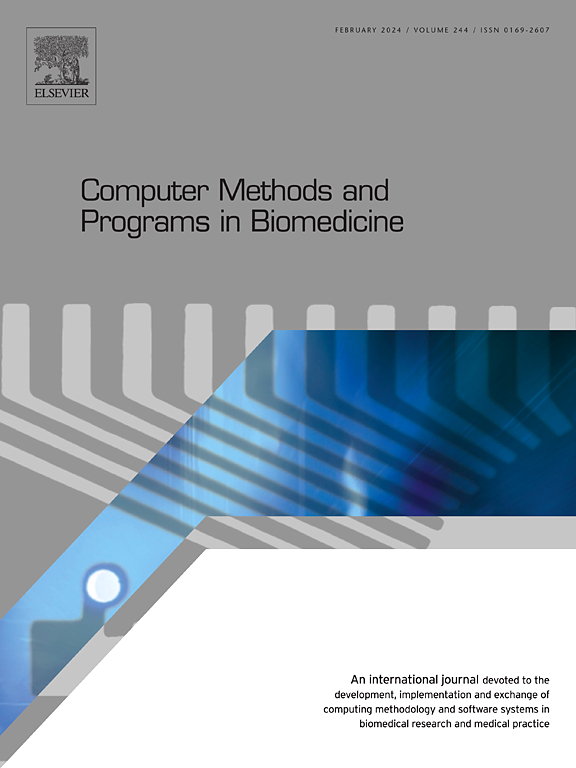Evaluation of the impacts of neuromuscular electrical stimulation based on cortico-muscular-cortical functional network
IF 4.8
2区 医学
Q1 COMPUTER SCIENCE, INTERDISCIPLINARY APPLICATIONS
引用次数: 0
Abstract
Background and objective
Neuromuscular electrical stimulation (NMES) has been extensively applied for recovery of motor functions. However, its impact on the cortical network changes related to muscle activity remains unclear, which is crucial for understanding the changes in the collaborative working patterns within the sensory-motor control system post-stroke.
Methods
In this research, we have integrated cortico-muscular interactions, intercortical interactions, and intramuscular interactions to propose a novel closed-loop network structure, namely the cortico-muscular-cortical functional network (CMCFN). The framework is endowed with the capability to distinguish the directionality of causal interactions and local frequency band characteristics through transfer spectral entropy (TSE). Subsequently, the CMCFN is applied to stroke patients to elucidate the potential influence of NMES on cortical physiological function changes during motor induction.
Results
The results indicate that short-term modulation by NMES significantly enhanced the cortico-muscular interactions of the contralateral cerebral hemisphere and the affected upper limb (p < 0.001), while coexistence of facilitatory and inhibitory effects is observed in the intermuscular coupling across different electromyography (EMG) signals. Furthermore, following NMES treatment, the connectivity of the brain functional network is significantly strengthened, particularly in the γ frequency band (30–45 Hz), with marked improvements in the clustering coefficient and shortest path length (p < 0.001).
Conclusions
As a new framework, CMCFN offers a novel perspective for studying motor cortical networks related to muscle activity.
基于皮质-肌肉-皮质功能网络的神经肌肉电刺激影响评价
背景与目的神经肌肉电刺激(NMES)已广泛应用于运动功能的恢复。然而,它对与肌肉活动相关的皮质网络变化的影响尚不清楚,这对于理解中风后感觉-运动控制系统内协同工作模式的变化至关重要。方法本研究将皮质-肌肉相互作用、皮质间相互作用和肌肉内相互作用整合在一起,提出了一种新的闭环网络结构,即皮质-肌肉-皮层功能网络(CMCFN)。该框架具有通过传递谱熵(TSE)区分因果相互作用的方向性和局部频带特征的能力。随后,将CMCFN应用于脑卒中患者,以阐明NMES对运动诱导过程中皮层生理功能变化的潜在影响。结果NMES短期调节显著增强了对侧大脑半球和患肢的皮质-肌肉相互作用(p <;0.001),而在不同肌电图(EMG)信号的肌间耦合中观察到促进和抑制作用共存。此外,NMES处理后,大脑功能网络的连通性显著增强,特别是在γ频段(30-45 Hz),聚类系数和最短路径长度显著改善(p <;0.001)。结论CMCFN作为一个新的框架,为研究与肌肉活动相关的运动皮质网络提供了一个新的视角。
本文章由计算机程序翻译,如有差异,请以英文原文为准。
求助全文
约1分钟内获得全文
求助全文
来源期刊

Computer methods and programs in biomedicine
工程技术-工程:生物医学
CiteScore
12.30
自引率
6.60%
发文量
601
审稿时长
135 days
期刊介绍:
To encourage the development of formal computing methods, and their application in biomedical research and medical practice, by illustration of fundamental principles in biomedical informatics research; to stimulate basic research into application software design; to report the state of research of biomedical information processing projects; to report new computer methodologies applied in biomedical areas; the eventual distribution of demonstrable software to avoid duplication of effort; to provide a forum for discussion and improvement of existing software; to optimize contact between national organizations and regional user groups by promoting an international exchange of information on formal methods, standards and software in biomedicine.
Computer Methods and Programs in Biomedicine covers computing methodology and software systems derived from computing science for implementation in all aspects of biomedical research and medical practice. It is designed to serve: biochemists; biologists; geneticists; immunologists; neuroscientists; pharmacologists; toxicologists; clinicians; epidemiologists; psychiatrists; psychologists; cardiologists; chemists; (radio)physicists; computer scientists; programmers and systems analysts; biomedical, clinical, electrical and other engineers; teachers of medical informatics and users of educational software.
 求助内容:
求助内容: 应助结果提醒方式:
应助结果提醒方式:


